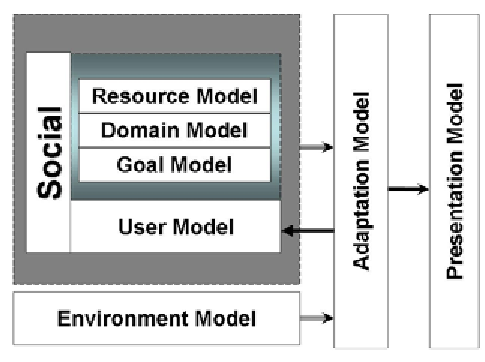Information Technology Reference
In-Depth Information
Figure 1 shows that the different categories of
users are not represented by a single point in the
users-rights space, but that they could be defined
anywhere within a segment of the graph. For
instance, a
student
could have only reading rights
and nothing more, being at the beginning of the
segment of students. However, a student could
have tagging rights, or even rights of editing their
own or group items - thus being placed at the end
of the segment. Similarly, a
teacher
could just
have rating rights, basically marking students, or
could have complex authoring rights, being able
to edit their own modules or even modules outside
their own group.
Authors
, by definition, should
have at least
some
authoring rights, e.g. rights for
editing their own items. At the end of the scale,
authors could author, in groups or by themselves,
any given items or modules. Finally, the role with
maximum rights is that of the
administrator
, who
can do any of the tasks done by students, teachers
and authors, and any other tasks which are pres-
ent in the system.
Note that this graph is for orientation only,
and it does not represent all possible users or all
possible rights. Whilst we attempted to order the
rights for the figure, other orders are possible,
depending on the system they are applied to. Also
note that no monotonic increase is assumed.
Figure 1 already displays an extended idea
of rights for student, teacher, and author, where
teachers and authors are just students with more
rights. However, in the context of lifelong learning,
it is important to note that these segments can be
extended even further, and that the fuzzy differ-
ence between the roles could disappear altogether,
leaving only one type of user with a set of rights.
The progression to a higher level of rights has to
be established outside this figure, depending on
the goal of the system. For example, if the goal
of the system is to teach writers, and ultimately to
allow them all to collaborate in a wiki-like manner,
a user could progress from initial reading rights
all the way to editing other modules, depending,
for example, on peer evaluations, trust, etc.
Figure 2 illustrates the addition of a new layer,
the
social layer
, to LAOS, which expresses all
social activities within Adaptive Hypermedia
Systems. These
social activities
include, but are
not limited to:
1.
collaborative authoring
(editing content of
other users, describing content using tags,
rating, commenting on the content, etc.);
Figure 2. Social LAOS framework

Search WWH ::

Custom Search